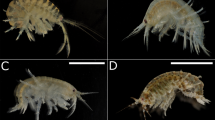Abstract
Because of taxonomic diversity, geographic isolation, and other considerations, subterranean ground-water amphipods would appear to make excellent candidates for biogeographic studies. Limted dispersal ability in combination with local endemism makes it likely that vicariance models will generally offer better explanations for present distribution patterns of subterranean amphipods than scenarios based on centers of origin and dispersal. Vicariance biogeography demands a knowledge of both phylogeny and area relationships, which are typically shown on biological area cladograms. To date most biogeographic studies on subterranean amphipods have been limited to cladograms of single taxonomic groups. Although useful in showing possible relationships between areas and nested subsets of taxa, these single taxon studies do not consider covariant patterns among different groups. However, in order to be fully effective, future biogeographic research will have to focus on analyses of congruence between biological area cladograms of amphipod taxa and other subterranean crustacean groups, such as isopods. To date many covariant distributions among groups of subterranean crustaceans have been recognized but not yet analyzed for congruence.
Access this chapter
Tax calculation will be finalised at checkout
Purchases are for personal use only
Similar content being viewed by others
References
Boutin, C. & N. Coineau, 1988. Pseudoniphargus maroccanus n. sp. (subterranean amphipod), the first representative of the genus in Morocco. Phylogenetic relationships and paleobiogeography. Crustaceana, Suppl. 13: 1–19.
Holsinger, J. R., 1986. Zoogeographic patterns of North American subterranean amphipod crustaceans. In R. H. Gore & K. L. Heck (eds), Crustacean Biogeography (Crustacean Issues 4). A.A. Balkema, Rotterdam: 85–106.
Holsinger, J. R., 1989. Preliminary Zoogeographic analysis of five groups of crustaceans from anchialine caves in the West Indian region. Proc. 10th Int. Congr. Speleol., Budapest 1: 25–26.
Holsinger, J. R. & G. Longley, 1980. The subterranean amphipod crustacean fauna of an artesian well in Texas. Smithson. Contr. Zool. 308, 1–62.
Humphries, C. J., P. Y. Ladiges, M. Roos & M. Zandee, 1988. Cladistic biogeography. In A. A. Myers & P. S. Giller (eds), Analytical Biogeography, Chapman & Hall, London: 371–404.
Myers, A. A., 1988. A cladistic and biogeographic analysis of the Aorinae subfamily nov. Crustaceana, Suppl. 13: 167–192.
Notenboom, J., 1988. Phylogenetic relationships and biogeography of the groundwater-dwelling amphipod genus Pseudoniphargus (Crustacea), with emphasis on the Iberian species. Bijdr. Dierk. 58 (2): 159–204.
Stock, J. H., 1980. Regression model evolution as exemplified by the genus Pseudoniphargus (Amphipoda). Bijdr. Dierk. 50: 104–144.
Stock, J. H. & B. L. M. Rondé-Broekhuizen, 1986. A new species of Pygocrangonyx, an amphipod genus with African affinities, from Fuerteventura. Bijdr. Dierk. 56 (2): 247–266.
Wiley, E. O., 1988. Vicariance biogeography. Ann. Rev. Ecol. Syst. 19: 513–542.
Author information
Authors and Affiliations
Editor information
Editors and Affiliations
Rights and permissions
Copyright information
© 1991 Springer Science+Business Media Dordrecht
About this chapter
Cite this chapter
Holsinger, J.R. (1991). What can vicariance biogeographic models tell us about the distributional history of subterranean amphipods?. In: Watling, L. (eds) VIIth International Colloquium on Amphipoda. Developments in Hydrobiology, vol 70. Springer, Dordrecht. https://doi.org/10.1007/978-94-011-3542-9_5
Download citation
DOI: https://doi.org/10.1007/978-94-011-3542-9_5
Publisher Name: Springer, Dordrecht
Print ISBN: 978-94-010-5568-0
Online ISBN: 978-94-011-3542-9
eBook Packages: Springer Book Archive




